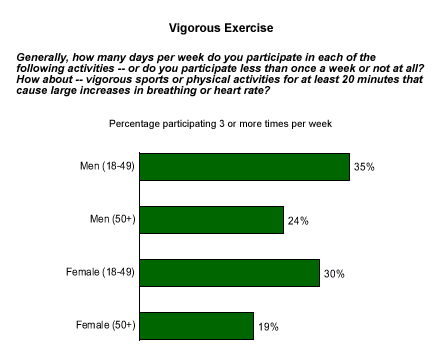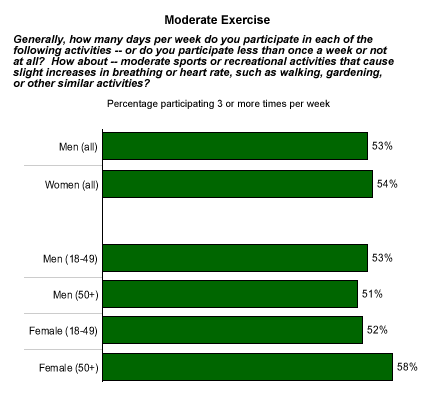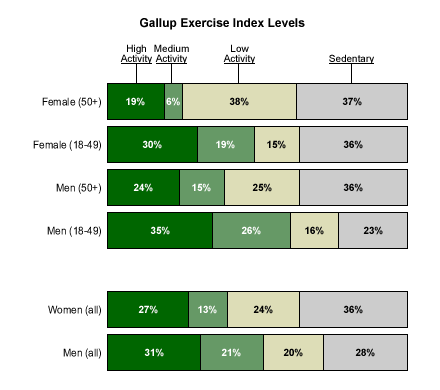Homer Simpson may be the prototypical pop-culture example of a couch potato, but Gallup data suggest that women are more likely than men to fit that description when it comes to exercise. Women's responses to a November 2002 Gallup Poll* on health and healthcare indicate lower levels of participation in vigorous exercise than men's levels, and lower levels of physical activity overall. And while younger women (aged 18 to 49) are far more likely than both older women and older men to exercise regularly, they were less likely to say they exercise than men in their own age group.
The findings are especially relevant given the fact that the question of how much exercise is necessary to stay healthy is being revisited because of the results of several recent health studies. While all researchers agree that any exercise is far better than none, a Harvard study published last October in the Journal of the American Medical Association indicated that vigorous exercise may offer considerably greater benefits than moderate-intensity exercise when in comes to reducing the risk of heart disease. (See Related Sites.) On the other hand, another Harvard study of more than 73,000 postmenopausal women published in September found women's risk of heart disease dropped by comparable levels (30% to 40%) whether they engaged in vigorous exercise or took a brisk 30-minute walk every day.
Type of Exercise
When it comes to vigorous exercise -- that is, at least 20 minutes of sports or physical activity that causes large increases in breathing or heart rate -- age plays a role. While only 19% of women aged 50 and older exercise vigorously three or more times per week, women aged 18 to 49 are far more active, with 30% showing a high level of vigorous activity on a weekly basis. But young women still fall slightly short of young men, 35% of whom said they vigorously exercise that frequently, on average.

On the other hand, participation in moderate exercise -- that is, "sports or recreational activities that cause a slight increase in breathing or heart rate, such as walking, gardening, or other similar activities" -- does not differ notably by gender. Just over half of men and women (53% and 54%, respectively) said they get moderate exercise three or more times per week.
In fact, while younger women, younger men, and older men are all similarly likely to perform moderate exercise (between 51% and 53%), a slightly greater percentage of women aged 50 and older exercise moderately. In other words, while older women are far less likely than other groups to engage in high-intensity exercise, they are slightly more likely to engage in low-intensity exercise.

Total Exercise
How do the overall activity levels of older women compare to those of other groups? Gallup's Exercise Index is a four-category composite indicator of both type of exercise and average number of days per week of different intensity exercises, and categorizes activity levels according to the following groupings:
|
High Activity |
Vigorously exercise 3 times or more per week |
|
Medium Activity |
Vigorously exercise 1 or 2 times per week |
|
Low Activity |
Moderately exercise 3 or more times per week, with |
|
Sedentary |
Moderately exercise less than 3 times per week, with no regular weekly vigorous exercise |
Comparing activity levels on this Index suggests that older women fall substantially behind other groups. When looking at the percentages of people in the "low activity" and "sedentary" categories, women aged 50 and older are far less active than people in other groups, with three-fourths (75%) falling into these two categories. Younger women are far more active than older men, with 51% of 18- to 49-year-old women and 61% of men aged 50 and older categorized as "low activity" or "sedentary." Young men are by far the most active group, with only 39% falling into the lower activity levels.

Bottom Line
In 1996, the U.S. surgeon general released an influential report scaling back recommendations for physical activity, with the realization that too many Americans were sedentary and needed to be urged to engage in at least a minimal level of physical activity. That report advised 30 minutes of moderate-intensity exercise on all or most days of the week.
New studies have questioned the wisdom of de-emphasizing the benefits of more vigorous exercise. The question is especially important to older women, who are less likely than men or younger women to engage in any vigorous activity, though they are at least as likely to say they engage in moderate exercise. The difference may be a result of social change: many women over 50 were not encouraged to participate in sports as children, and before the passage of Title IX in 1972, girls generally had less access to school sports activities than boys (see "What Do Americans See in Title IX's Future?" in Related Items).
Today, young girls are widely encouraged to participate in both school and extra-curricular sports. Moreover, the benefits of exercise -- whether moderate or vigorous -- for both genders has been emphasized increasingly over the past several decades. The true test of the degree to which exercise levels differ by gender will take place as today's children age into adults.
*Results are based on telephone interviews with 1,001 national adults, aged 18 and older, conducted Nov. 8-11, 2002. For results based on the total sample of national adults, one can say with 95% confidence that the maximum margin of error is ±3%.